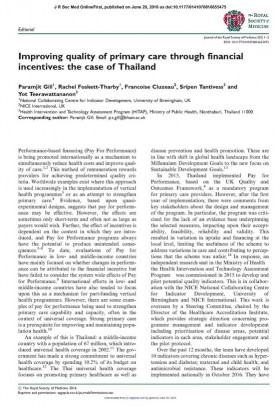This website uses cookies so that we can provide you with the best user experience possible. Cookie information is stored in your browser and performs functions such as recognising you when you return to our website and helping our team to understand which sections of the website you find most interesting and useful.
Improving quality of primary care through financial incentives: the case of Thailand. (2016)

Details
Improving quality of primary care through financial incentives: the case of Thailand.
Paramjit Gill1, Rachel Foskett-Tharby1, Francoise Cluzeau2, Sripen Tantivess3 and Yot Teerawattananon3
1National Collaborating Centre for Indicator Development, University of Birmingham, UK
2NICE International, UK
3Health Intervention and Technology Assessment Program (HITAP), Ministry of Public Health, Nonthaburi, Thailand 11000
Corresponding author: Paramjit Gill. Email: [email protected]
Performance-based financing (Pay For Performance) is being promoted internationally as a mechanism to simultaneously reduce health costs and improve quality of care.1,2 This method of remuneration rewards providers for achieving predetermined quality criteria. Worldwide examples exist where this approach is used increasingly in the implementation of vertical health programmes3 or as an attempt to strengthen primary care.4 Evidence, based upon quasi-experimental designs, suggests that pay for performance may be effective. However, the effects are sometimes only short-term and often not as large as payers would wish. Further, the effect of incentives is dependent on the context in which they are introduced, and Pay for Performance programs always have the potential to produce unintended consequences.5⇓⇓–8 To date, evaluations of Pay for Performance in low- and middle-income countries have mainly focused on whether changes in performance can be attributed to the financial incentive but have failed to consider the system wide effects of Pay for Performance.9 International efforts in low- and middle-income countries have also tended to focus upon this as a mechanism for part-funding vertical health programmes. However, there are some examples of pay for performance being used to strengthen primary care capability and capacity, often in the context of universal coverage. Strong primary care is a prerequisite for improving and maintaining population health.10
An example of this is Thailand: a middle-income country with a population of 67 million, which introduced universal health coverage in 2002.11 The government has made a strong commitment to universal health coverage by spending 10.2% of its budget on healthcare.12 The Thai universal health coverage focuses on promoting primary healthcare as well as disease prevention and health promotion. These are in line with shift in global health landscape from the Millennium Development Goals to the new focus on Sustainable Development Goals.13
In 2013, Thailand implemented Pay for Performance, based on the UK Quality and Outcomes Framework,4 as a mandatory program for primary care providers. However, after the first year of implementation, there were comments from key stakeholders about the design and management of the program. In particular, the program was criticised for the lack of an evidence base underpinning the selected measures, impacting upon their acceptability, feasibility, reliability and validity. This resulted in variation in uptake and financing at the local level, limiting the usefulness of the scheme to address variations in care and contributing to perceptions that the scheme was unfair.14 In response, an independent research unit in the Ministry of Health – the Health Intervention and Technology Assessment Program – was commissioned in 2015 to develop and pilot potential quality indicators. This is in collaboration with the NICE National Collaborating Centre for Indicator Development, University of Birmingham and NICE International. This work is overseen by a Steering Committee, chaired by the Director of the Healthcare Accreditation Institute, which provides strategic direction concerning programme management and indicator development including prioritisation of disease areas, potential indicators in each area, stakeholder engagement and the pilot protocol.
Over the past 12 months, the team have developed 10 indicators covering chronic diseases such as hypertension and diabetes; maternal and child health; and antimicrobial resistance. These indicators will be implemented nationally in October 2016. They have been developed with frontline healthcare professionals and, in contrast to indicators developed in many high-income countries, embrace population-based health improvement and disease prevention.
While the original scheme was inspired by the UK experience, it is now being developed more sensitively to the Thai context and population health priorities, supported by the strengthening of guideline development in the country. Additionally, the scheme covers a wide range of health problems, namely non-communicable diseases, maternal and child health and infectious diseases, targeting different population groups and that would provide invaluable experience to other resource-limited settings committed to universal health coverage. Future evaluation will need to address the extent to which this revised development process improves the acceptability of the scheme, addresses implementation differences and improves care quality and population outcomes.
Full Text: http://jrs.sagepub.com/content/early/2016/05/20/0141076816655475.full




